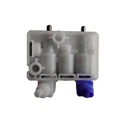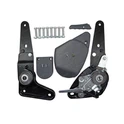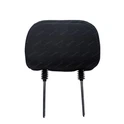Mechanical vs. Air suspension seats - Science of Driver Well-being
When it comes to selecting the right seat for long-haul truckers, administrators of overwhelming apparatus, or anybody who spends amplified periods sitting, the choice between Mechanical Suspension Seats and air suspension seats can have a noteworthy effect on by and large consolation, well-being, and productivity.
While both types of seats aim to reduce the jarring effects of vibrations and bumps, their underlying mechanisms and scientific principles differ substantially.
Mechanical Suspension Seats: A Robust and Time-Tested Solution
Mechanical suspension rely on a system of coil springs, torsion bars, and dampers to absorb shocks and vibrations. These seats are designed to counteract the vertical movements and jolts experienced during driving or operating machinery. The coil springs act as the primary shock absorbers, compressing and rebounding to dissipate the force of impacts. Torsion bars, on the other hand, offer assistance to control the seat's sidelong and rotational developments, anticipating intemperate side-to-side or turning movements that can cause discomfort.
The science behind Mechanical Suspension Seats lies in their ability to isolate the operator from the majority of low-frequency vibrations, which are the most detrimental to human health and comfort. By viably hosing these vibrations, mechanical seats offer assistance to diminish the risk of back torment, weariness, and long-term musculoskeletal clutters related with drawn out introduction to whole-body vibrations.

Air suspension seats: A Cushioned Ride with Advanced Technology
Air suspension seats, as the name suggests, utilize compressed air to provide a smoother and more responsive ride. These seats typically feature an air-filled bladder or a series of interconnected air cells that adjust to the operator's weight and movements. The air pressure within the bladder or cells can be adjusted manually or automatically to achieve the desired level of firmness and support.
The science behind these seats revolves around their ability to adapt to varying load conditions and terrain irregularities. As the seat encounters bumps or uneven surfaces, the air cells or bladder compress and expand, effectively absorbing the impact and minimizing the transfer of vibrations to the operator's body. This dynamic response not only enhances comfort but also helps to reduce fatigue and minimize the risk of injury associated with prolonged exposure to whole-body vibrations.

Durability and Cost-Effectiveness: Weighing the Pros and Cons
While both them offer unique benefits in terms of comfort and vibration dampening, it's essential to consider their durability, maintenance requirements, and cost-effectiveness when making a long-term investment.
Mechanical Suspension Seats: Rugged and Low-Maintenance
One of the key advantages is their robust construction and minimal maintenance requirements. These seats are typically built with heavy-duty materials like steel coils and torsion bars, designed to withstand the rigors of daily use in demanding environments. The simplicity of their design also means fewer moving parts and potential points of failure, contributing to their overall durability and longevity.
In terms of cost-effectiveness, these seats often have a lower initial investment compared to their air suspension counterparts. While the upfront cost may be higher than a basic non-suspension seat, the long-term savings in reduced maintenance and replacement costs can make mechanical seats a more economical choice in the long run.
Air suspension seats: Comfort at a Premium
While offering exceptional comfort and adaptability, they can be more susceptible to wear and tear over time. The air bladders or cells can develop leaks or punctures, leading to a gradual loss of air pressure and compromised performance. Additionally, the electronic components and compressors used to regulate the air pressure may require periodic maintenance or replacement, adding to the overall ownership costs.
The advanced technology and materials used in air seats also contribute to their typically higher initial purchase price. However, for operators who prioritize maximum comfort and minimal fatigue, the investment in an air suspension driver seat may be justified by the potential benefits to their overall well-being and productivity.
Making an Informed Choice:
When it comes to selecting the right suspension seat, there is no one-size-fits-all solution. The optimal choice will depend on a variety of factors, including the operator's individual needs, driving habits, and the type of work they perform.
For long-haul truckers or operators who spend the majority of their workday on the road or operating heavy machinery, an air seat may be the preferable option. The superior comfort and adaptability of these seats can help mitigate the effects of prolonged sitting and exposure to vibrations, potentially reducing the risk of back pain, fatigue, and other health issues associated with their profession.
On the other hand, for operators in industries like construction, mining, or agriculture, where the working environment is particularly rugged and demanding, a Mechanical Suspension Seat may be the more practical choice. The durability and low maintenance requirements of these seats can make them better suited for harsh conditions, while still providing a significant improvement in comfort and vibration dampening compared to non-suspension seats.
It's also important to consider the operator's individual preferences and body type when selecting a suspension seat. Some operators may prefer the firm and consistent support of a mechanical seat, while others may find the adjustable firmness and contouring of an air suspension seat more comfortable.
Ultimately, the decision between them should be based on a careful evaluation of your specific needs, working conditions, and budget constraints. Consulting with professionals or seeking advice from experienced operators in your industry can also provide valuable insights to help you make an informed choice.
Both types of seats can be purchased at YSR.To learn more about YSR seats, please contact us at sales@ysrseats.com.
References:
1. Eger, T., Salmoni, A., Cann, A., & Jack, R. (2008). Whole-body vibration exposure study in heavy trucks operating on uneven terrain. Canadian Acoustics, 36(3), 40-49.
2. Videman, T., Simonen, R., Kloven, K., Battie, M. C., Gibbons, L. E., & Manninen, H. (2000). The long-term effects of a semi-rigid lumbar support on the spine. Scandinavian Journal of Rehabilitation Medicine, 32(3), 109-115.
3. Huissoud, T., Occelli, B., Sauzeau, V., & Bremont, J. (2020). Characterization of air suspension seat transmissibility for off-road vehicles. Mechanics & Industry, 21(1), 107.







